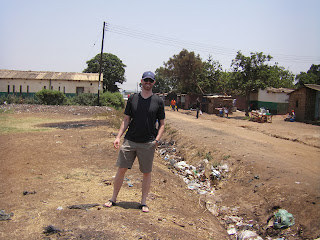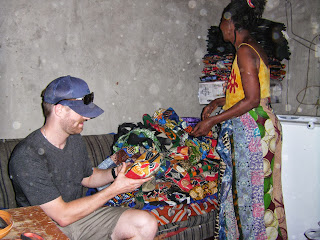The compound we were in is called the Garden Compound. It is called this b/c during the colonial times, it was a large farm, due to the fertile land. Now it is the home of the Lusaka Water and Sewage water treatment facilities, so there is a distinct smell to this area. Apparently they drain the sewage ponds (open air ponds) twice a year, and people will then go into the emptied pools and collect the soil as fertilizer.
 Here are some pics of a local learning center that is funded by non-profits like World Vision and USAid. These are built in communities where you have a lot of at risk children (usually due to families being poor and parents not being able to afford things like school uniforms and books), and they provide a library and opportunities to work on laptop computers for free. Here are two pics from the computer area. The kids were working on math problems and other educational games.
Here are some pics of a local learning center that is funded by non-profits like World Vision and USAid. These are built in communities where you have a lot of at risk children (usually due to families being poor and parents not being able to afford things like school uniforms and books), and they provide a library and opportunities to work on laptop computers for free. Here are two pics from the computer area. The kids were working on math problems and other educational games.
This next sequence was from an unexpected but fun stop at a local gymnasium. The gym was super small. It was probably about a 10 x 10 ft room or at best a 12 x 12 ft room where there were about 8 guys lifting weights. I noticed that some of the weights they were using were actually large gears from some type of industrial use. Again, they were actually using large gears for plates to put on barbells. It was awesome. I of course had to get in on the action, and you can see where I was struggling on my 10 reps the Zambians told me I had to do (notice the old school strong man picture on the wall). The owner of the gym introduced himself as Big Robert and you can see me talking to him (bottom pic in white shirt), as he gives me a few pointers on how to not be a little girly man, while also inviting me to come back and visit his gym.
Here are two pics from a local sewing business that a woman named Charity runs out of her house. She makes things like purses, zippered pouches and oven mitts. These are then sold to vendors who peddle them at the local markets. She also teaches children and other women how to sew, so that they can also be self-sufficient. Charity is married, but as I understand, she is the primary bread winner in her family, through her sewing business.
For lunch we stopped in a small restaurant/house (10 x 10 ft) that a local woman ran. Here we had some local Zambian cuisine. You can see on the first plate kapenta (small cooked fish - kinda salty tasting) and rape (some kind of green). In the second pic, you can see the staple Zambian food known as nshima. It is simply ground maize that basically serves as an edible fork. You roll up a small piece of nshima and use it to put the other food on top of, then you eat it as one. It's not too bad. Basically, the nshima is a tasteless starch, and it all comes down to what you're eating it with that dictates the taste of the meal.
 Here I am with some local artwork that has been done on the side of some of the buildings. The first pic is of me next to a depiction of Oprah. Apparently when Oprah visited Zambia some years back, she had her picture taken at this location, so they painted her likeness there. In the bottom pic, you can see the little kid talking to me. Whenever I'd walk by little kids in the compound (being the VERY TOKEN white guy), I'd always hear murmurings of the word "muzungu". It means "white person", but it is not a derogatory term. The kids would often want to talk to me, stare at me or would sometimes give me a high-five. Basically, I was an anomaly that was out of the ordinary for them to see in this area, apart from other tour groups that Lusaka Experience took through.
Here I am with some local artwork that has been done on the side of some of the buildings. The first pic is of me next to a depiction of Oprah. Apparently when Oprah visited Zambia some years back, she had her picture taken at this location, so they painted her likeness there. In the bottom pic, you can see the little kid talking to me. Whenever I'd walk by little kids in the compound (being the VERY TOKEN white guy), I'd always hear murmurings of the word "muzungu". It means "white person", but it is not a derogatory term. The kids would often want to talk to me, stare at me or would sometimes give me a high-five. Basically, I was an anomaly that was out of the ordinary for them to see in this area, apart from other tour groups that Lusaka Experience took through.As stated before, this is a low income compound, so here is a pic (not very good) of the scope of the nicest commercial area they have in the compound. It was comprised of a bank, restaurants, a barbershop and other odds and ends.
 Despite what you've otherwise read, the most adventurous part of this excursion was documented in this picture. It was when I drank Shake Shake, which is a local line of beer that is served in a large carton, which you have to shake before you drink it. The reason you have to shake it is b/c it is not filtered like beer we're used to drinking, so there are a substantial amount of solids in the beer that are from the fermenting process. It is all very safe to consume, but that is of course if you are willing to deal with the WRETCHED taste of it. I threw back one small cup of it, as did my guide and the local DJ with whom I'm pictured (real name is "Linda", DJ name is "Cash Money"), then I gave the rest to a guy on the street.
Despite what you've otherwise read, the most adventurous part of this excursion was documented in this picture. It was when I drank Shake Shake, which is a local line of beer that is served in a large carton, which you have to shake before you drink it. The reason you have to shake it is b/c it is not filtered like beer we're used to drinking, so there are a substantial amount of solids in the beer that are from the fermenting process. It is all very safe to consume, but that is of course if you are willing to deal with the WRETCHED taste of it. I threw back one small cup of it, as did my guide and the local DJ with whom I'm pictured (real name is "Linda", DJ name is "Cash Money"), then I gave the rest to a guy on the street.
All in all, it was a great experience. I was really happy to take part in a Zambian-devised business that is run by a few young men, which really provides a real look into how the majority of the population lives. I also appreciated how these men took you to local vendors and brought further income into the community through that.
















Very interesting post. Gave a good look at what things look like there.
ReplyDelete